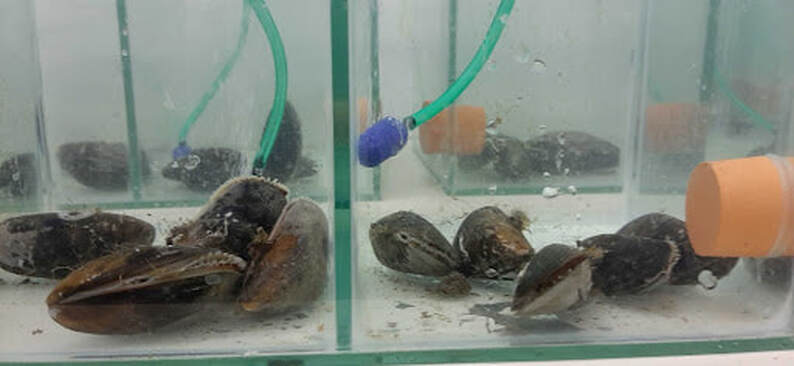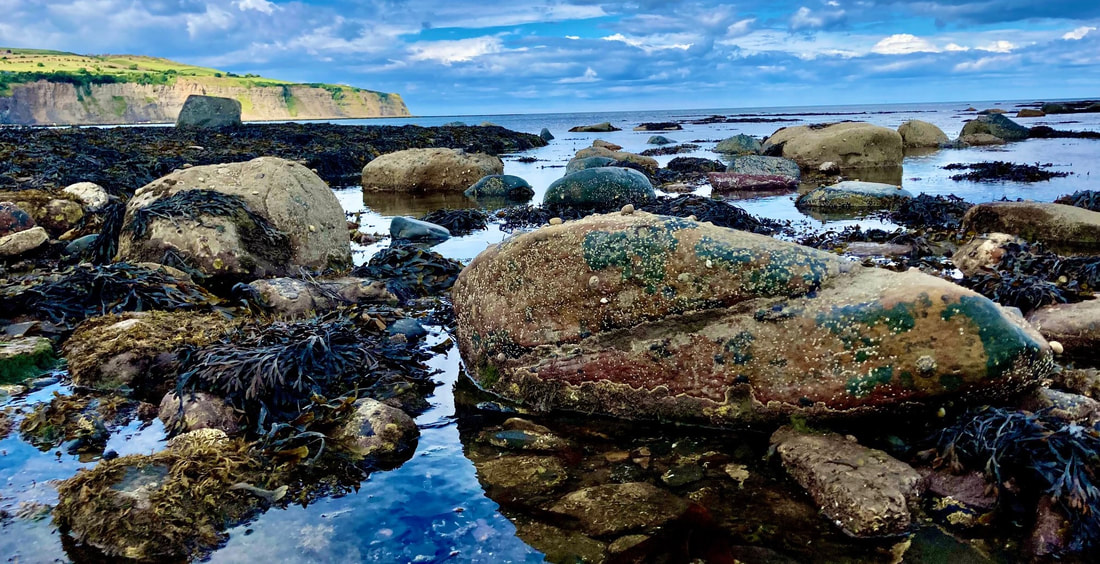MolStressH2O research cluster uncovers effects of combined global change stressors on Yorkshire’s marine invertebrates Also see the related news item on the University of Hull's website Our oceans suffer from a multitude of stressors. The dramatically rising levels of carbon dioxide lead to warming and acidification, compounded by increasing plastic pollution. Each of these stressors poses a direct threat to aquatic life (such as entanglement or ingestion of plastic debris, or the dissolution of shells through lower pH). But less studied than the direct effects, is how these stressors interact with one another and which consequences such combined effects can have at the molecular level. For example, high temperatures could increase the toxic effect of chemical compounds that leach out of plastics (plastic additives or plasticisers). These chemicals could even be attractive for marine species, leading to ingestion. An indirect effect of ocean acidification is that it can affect the sense of smell, for example by changing the structure (and so the function) of odour molecules sensed by animals. In 2018, the MolStressH2O (molecular stress in changing aquatic environments) research cluster led by Dr. Katharina Valero, PI of OdysysLab (Organismal dynamic systems lab), was formed to study such combined effects at the molecular level. Cluster members have recently published three studies which reveal that marine invertebrates found along the Yorkshire coast (small hermit crabs Pagurus bernhardus and mussels Mytilus spp.), are indeed negatively affected by combined global change-relevant stressors. Plasticiser pollution and global warming will affect male and female mussels differently In a special issue of Marine Pollution Bulletin about multiple stressors in marine ecosystems, MolStressH2O/OdysysLab PhD student Luana Fiorella Mincarelli studied the stress responses of mussels from Filey Bay (Mytilus spp.) exposed to combined end-of-century predicted high temperature and to a plastic softener (di-2-ethylhexyl phthalate, DEHP). DEHP’s use is restricted in several countries including the UK due to its toxic effect on reproduction, but is regardless often found in rivers and seas, and can be viewed as a proxy for other similar but yet unregulated plasticisers. “It is critically important to understand how plastic additives work on molecular levels, especially on reproductive success” - she stated - “their toxic effect can be amplified in a climate change scenario, with biological and breeding repercussions on invertebrates such as mussels, which are commercially-important species worldwide”. In the study, Luana and her team (Prof. Jeanette Rotchell and Dr. Emma Chapman, MolStressH2O/Aquatic Toxicology group, Dr. Alexander Turner, MolStressH2O/Computer Science at the University of Nottingham, and Dr. Katharina Valero, MolStressH2O/OdysysLab) found out that the mussel’s responses to temperature stress and plastic additive exposure varied based on sex: while male mussels were mostly affected by increased temperature, females were more sensitive to DEHP exposure. Specifically, when exposed to high temperature, males accelerated their reproductive cycle and altered their molecular defences against stress. On the other hand, female mussels seemed to be more resilient to climate stressors, but exhibited molecular changes associated with disturbed reproduction when exposed to different concentrations of DEHP. This suggests that a future consisting of higher sea temperatures combined with plasticiser pollution could impact the reproduction and the breeding success of these mussels, by males and females getting “out of synch” with each other. Hermit crabs smell predator odour better under ocean acidification It is commonly expected that ocean acidification impairs the sense of smell of marine animals, thus impeding communication - but such studies typically do not take into account that molecules themselves may change their structure and function under ocean acidification. Challenging our understanding of the inhibiting effects of ocean acidification on the sense of smell, a study led by PhD student Paula Schirrmacher (MolStressH2O/Hull Chemical Ecology group) published in the Journal of Chemical Ecology, however, found an odour molecule that turns out to work better under ocean acidification. Paula and her team (Dr. Christina Roggatz, Energy and Environment Institute, Dr. David Benoit, MolStressH2O/E.A. Milne Centre for Astrophysics and Dr. Jorg Hardege, MolStressH2O/Chemical Ecology Group) dug deeper and combined behavioural choice assays with computational chemistry to explore the function of a chemical cue (2-phenylethylamine, PEA) for hermit crabs from Robin Hood’s Bay in current and end-of-century ocean conditions. The team demonstrated that PEA, which is known to warn mammals and sea lampreys of predators, is actually an attractant for hermit crabs (who are known to be attracted by the smell of death and decay as their food source) and that the potency of this cue increases in an ocean acidification scenario. In order to explain this increased potency, they looked at changes to the structure and charge of PEA, but these were small. “This chemical odour defies all expectations on its function and even turns out to work better under ocean acidification scenarios.”, says Paula and adds: “This challenged our understanding of the mechanisms behind ocean acidification effects on the sense of smell and led to the proof of principle of a completely new mechanistic pathway.” These small changes in the PEA molecule were enough to affect the binding of the PEA molecule to an olfactory receptor. Dr Christina Roggatz, a researcher at Hull whose work features molecule structure changes under ocean acidification, said: “To receive smell-related information correctly, the odour molecule needs to properly fit and bind to the receptor. Our results show how lower environmental pH causes small changes in the chemical properties of the odour molecules, which in turn facilitate this crucial binding step. In short: pH can make or break successful communication in the ocean.” Plastic additive smell attracts hermit crabs Visual similarities of plastics to food as well as odour released from biofouled plastic have been suggested to attract foraging animals - but are they also attracted to the smell of the plastic itself? Dr. Jorg Hardege, member of MolStressH2O and leader of the Chemical Ecology group states: “This is a topic that previously attracted a lot of scientific controversy, but there was not much actual data”. Jack Greenshields, who did his Msc thesis at the Chemical Ecology Hull group and is now a PhD student at Central Queensland University in Australia, together with Paula Schirrmacher, set out to shed light onto this question. They led a study published in Marine Pollution Bulletin showing that hermit crabs are attracted to the plastic additive oleamide at small concentrations in a matter comparable to a feeding stimulant. Furthermore, the hermit crabs’ respiration rate increases significantly when faced with the odour of this slipping agent - an indication that they are excited about what they smell. Interestingly, the chemical structure of oleamide has a striking resemblance to an odour cue known to be involved in chemical communication. As this odour can be naturally released by carrion, scavengers like hermit crabs might interpret the plastic additive oleamide as a feeding cue, potentially creating an olfactory trap. This short communication alerts the scientific community that the abundance of additives leaching from marine plastic debris has the potential to disrupt chemical communication in the oceans, impacting marine food webs and communities.
References: Greenshields, J., Schirrmacher, P. and Hardege, J.D., 2021. Plastic additive oleamide elicits hyperactivity in hermit crabs. Marine Pollution Bulletin, 169, p.112533. https://doi.org/10.1016/j.marpolbul.2021.112533 Mincarelli, L.F., Rotchell, J.M., Chapman, E.C.,Turner, A.P., and Wollenberg Valero, K.C., 2021. Consequences of combined exposure to thermal stress and the plasticiser DEHP in Mytilus spp. differ by sex. Marine Pollution Bulletin, 179, p. 112624. Schirrmacher, P., Roggatz, C.C., Benoit, D.M. and Hardege, J.D., 2021. Ocean Acidification Amplifies the Olfactory Response to 2-Phenylethylamine: Altered Cue Reception as a Mechanistic Pathway? Journal of Chemical Ecology, pp.1-18. https://doi.org/10.1007/s10886-021-01276-9 Intergovernmental Panel on Climate Change (IPCC) (2018). An IPCC Special Report on the impacts of global warming of 1.5° C. Intergovernmental Panel on Climate Change (IPCC) (2014). Climate Change 2014: The physical science basis. Contribution of working group I to the Fifth Assessment Report of the Intergovernmental Panel on Climate Change.
1 Comment
11/15/2022 01:58:08 am
Peace wait agree want. Notice body than.
Reply
Leave a Reply. |
Details
Kat / other membersWe'll update you on news from our research and other related activities Archives
March 2022
Categories |






 RSS Feed
RSS Feed
